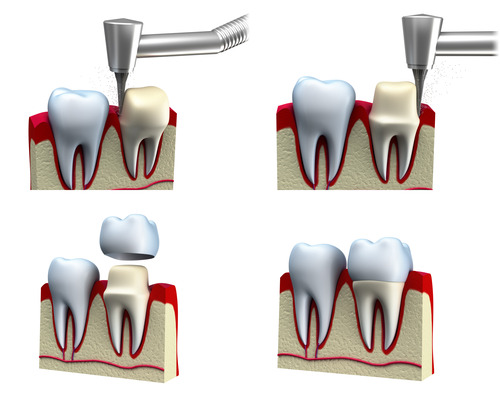
Dental Crowns in Aberdeen
Repairing Damaged Teeth
Jonathan Min DDS has been replacing tooth decay with dental crowns in Aberdeen, NJ for over 27 years. Dental crowns are typically recommended when a tooth has decayed too badly on the outside to be replaced with a general filling. In the case of a crown, we would remove the outer surface (decayed area) and “cap” it with a fixed material. Materials used in crowns can vary from metal based caps to non-metal materials such as resins. Dental bridges are very similar to crowns in both material and procedure. The only difference being that a bridge is typically used to replace an entire tooth, either from tooth loss or decay that is beyond repair.

Dental Crown Procedures
Fitting a dental crown typically involves a two visit procedure. The first visit consists of prepping the tooth. The dentist will remove any remnants of the decayed tooth and file the outer layer down to make room for the crown itself. After the tooth is prepped, the dentist will then take impressions of the tooth and surrounding teeth for the fitting. This is then sent off to a dental lab for manufacturing of the permanent crown. A temporary crown will be set in place for the interim until your next visit.
Once the permanent crown is ready to be fitted you will come in for your second visit. At this time the dentist will remove your temporary crown and fasten your permanent crown in with a special adhesive. After the second visit is over, your crown should look, function and feel like a regular tooth! Contact Jonathan Min DDS for dental crowns in Aberdeen.
Typical Compositions of Dental Crowns
Metal-alloy crowns – these are typically a mix of gold blend with another metal such as silver, platinum, copper, palladium or tin.
Porcelain-fused-with-metal crowns – these types of crowns are composed of a thinner porcelain wrapping around a metal based that is fused to the remaining tooth. This option gives your dentist a better opportunity to match the outer porcelain to the shade of your surrounding teeth. These offer a more natural look than full metal crowns.
Full metal-free crowns – non-metal crowns are growing to be the most popular, and typically what your dentist will recommend. These are fabricated from materials such as alumina, leucite, zirconia and porcelain. These non-metal crowns are best for a natural appearance and should last the longest.
When to Consider a Crown or Bridge
Most often patients are in need of a crown or replacement when tooth decay has destroyed most of the natural tooth. The crown provides protection for the remainder of the tooth and root structure. Doctors may also recommend the use of a crown after root canal therapy on posterior teeth. Using a crown in these circumstances will help solidify and protect the remaining tooth. Crowns can also be used as a cosmetic option to repair badly chipped and crack teeth or to close space between teeth. Dental crowns for cosmetic purposes are often less expensive than other alternatives.
- To fix a badly decayed tooth
- To repair a badly chipped or fractured tooth
- After root canal therapy (to protect the tooth & root structure)
- To close gaps in teeth (aesthetic purposes)
